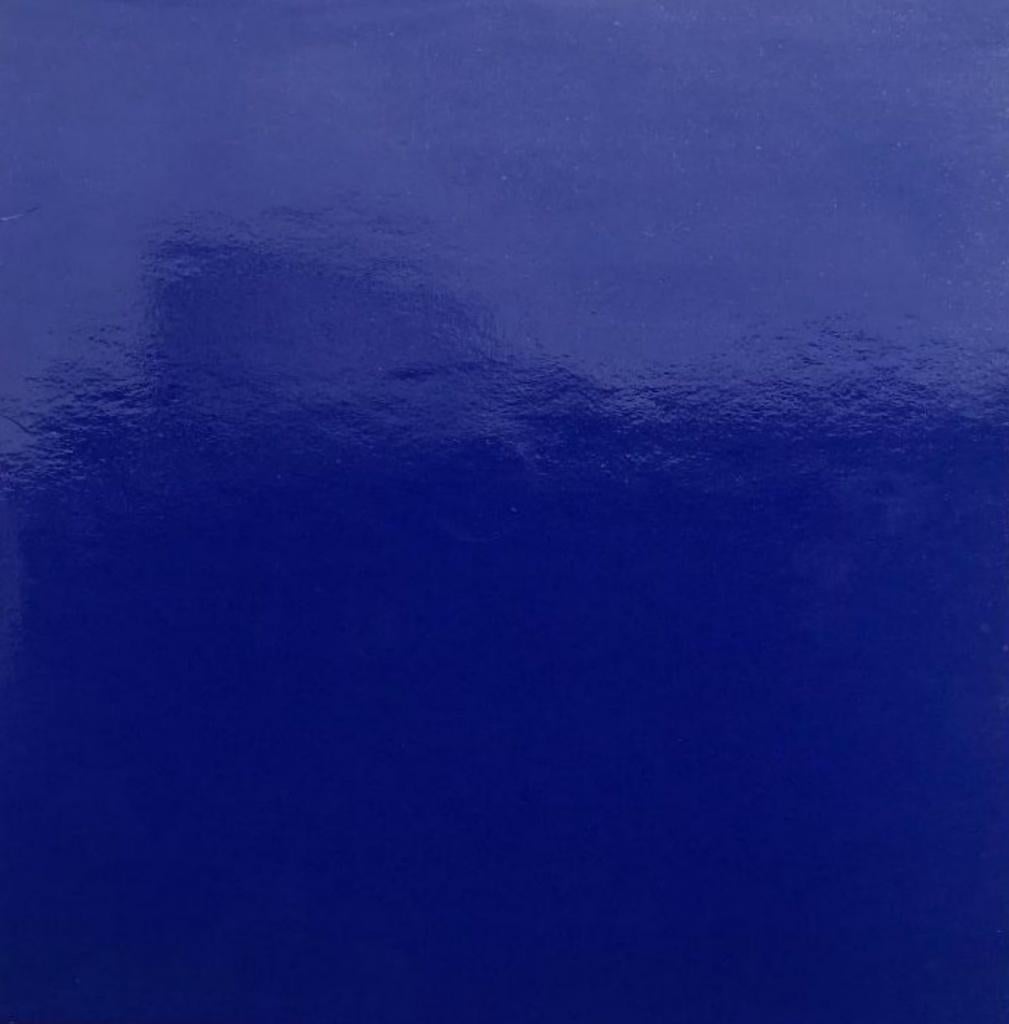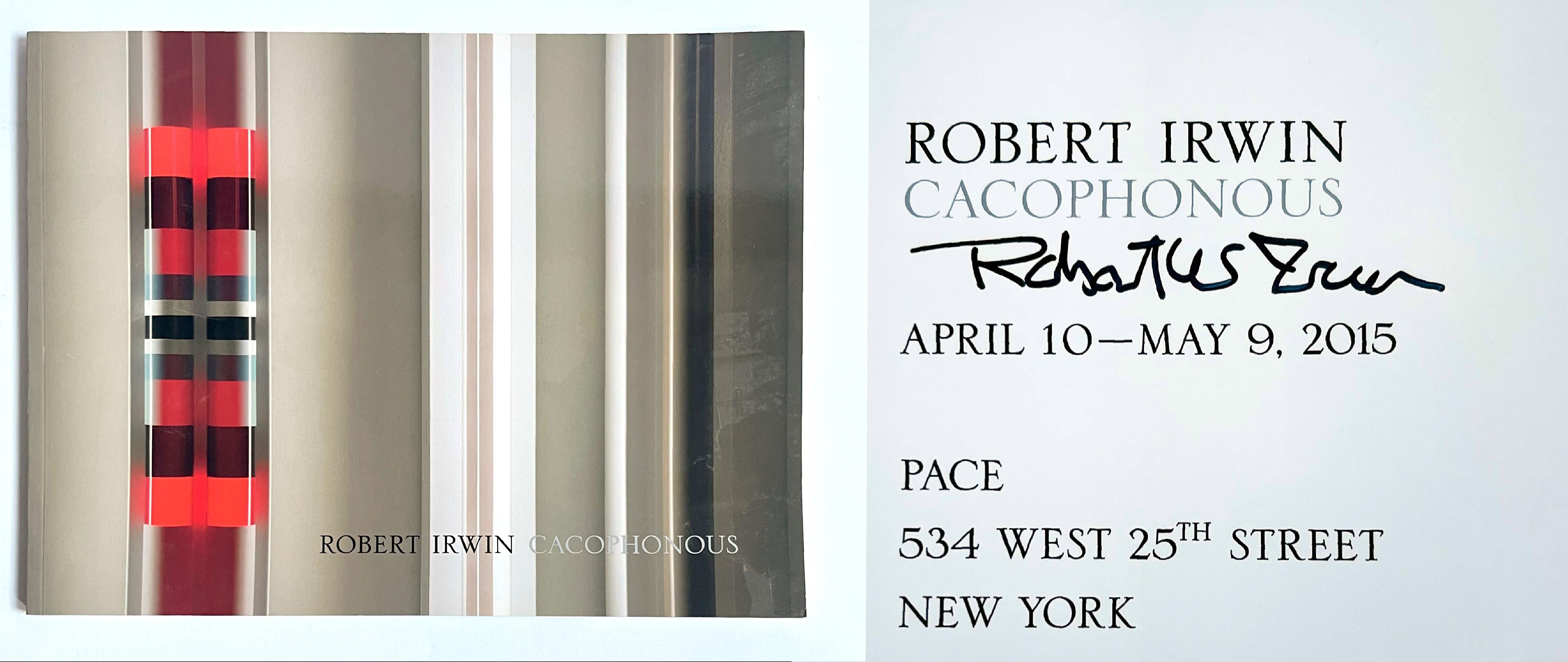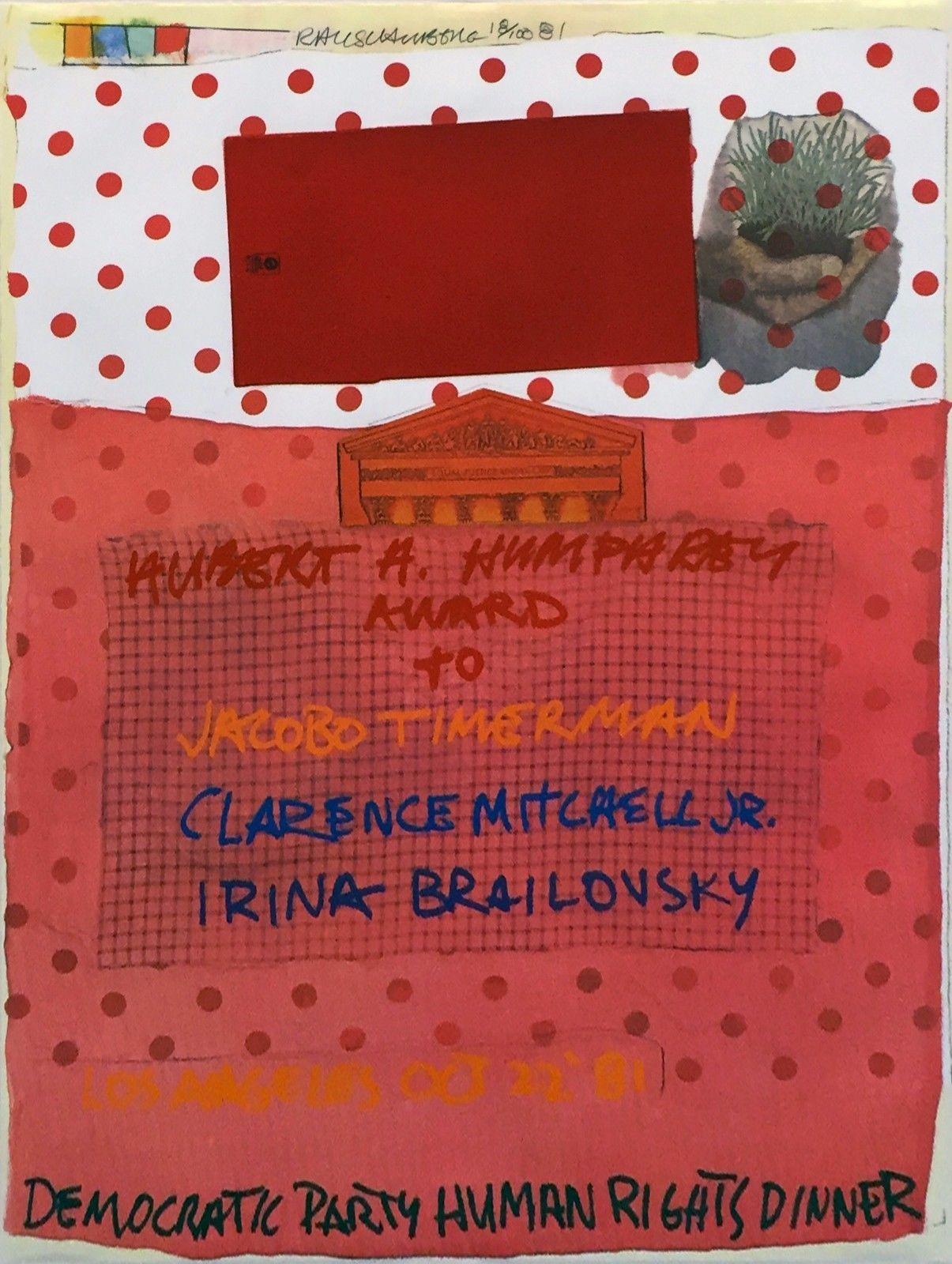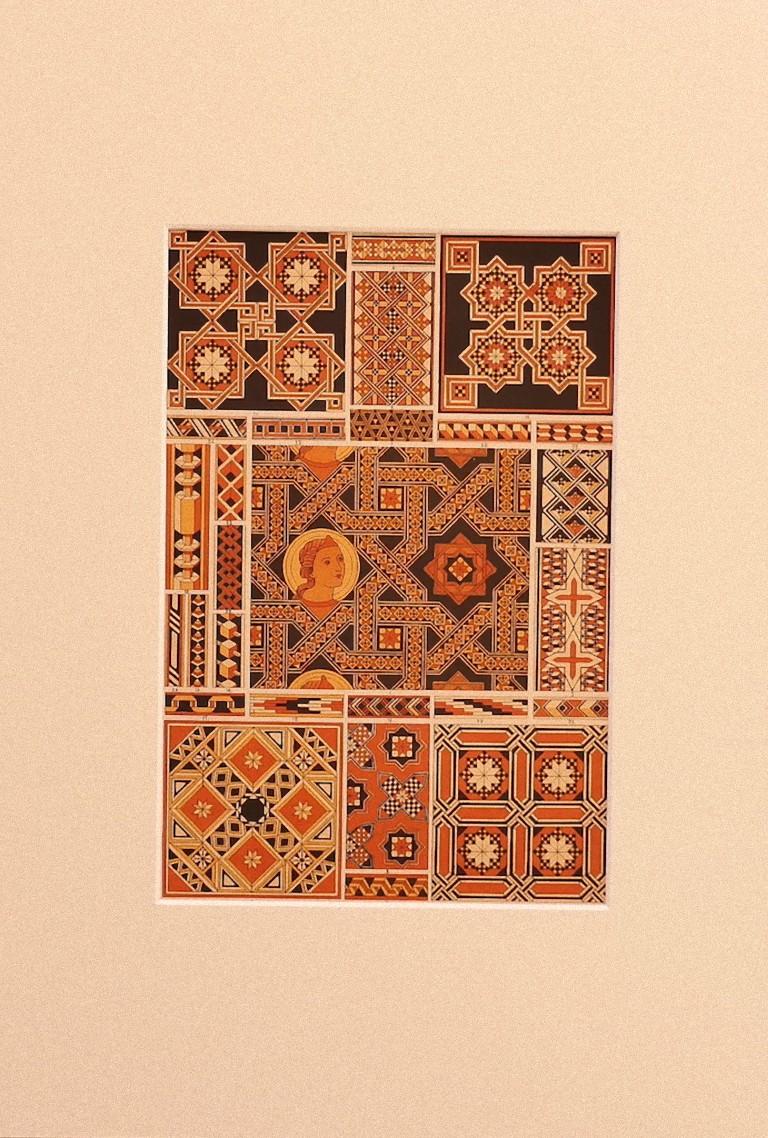Yves KleinYves Klein Propositions Monochromes Invite with IKB (International Klein Blue)1957
1957
About the Item
- Creator:Yves Klein (1928 - 1962, French)
- Creation Year:1957
- Dimensions:Height: 8.25 in (20.96 cm)Width: 11.75 in (29.85 cm)
- Medium:
- Movement & Style:
- Period:
- Condition:In good, stable vintage condition with expected folds, as issued. The IKB (International Klein Blue) color remains striking.
- Gallery Location:New York, NY
- Reference Number:1stDibs: LU1745213258722
Yves Klein
French artist Yves Klein is best known for his trademark ultramarine pigment, which he patented as International Klein Blue in 1961. “Blue … is beyond dimensions, whereas the other colors are not,” he said.
“All colors arouse specific ideas, while blue suggests at most the sea and the sky; and they, after all, are in actual, visible nature what is most abstract.”
Starting in the mid-1950s, Klein made retinal blue monochrome paintings (which would prove cornerstones of Minimalism) and the pigment would also feature prominently in his Anthropometry paintings, for which Klein smeared nude women with blue pigment and used them as human brushes on canvas, sometimes in elaborate public performances. Klein's work anticipated Conceptual art, performance art and environmental art, as in his selling of portions of empty space to collectors. For The Void (1958), he presented an empty gallery as an artwork, wearing a white tie and tails to show visitors around the blank walls.
Find authentic Yves Klein sculptures, prints and other art on 1stDibs.
- ShippingRetrieving quote...Ships From: New York, NY
- Return PolicyA return for this item may be initiated within 1 day of delivery.
- La Conférence à la Sorbonne, 3 Juin, 1959, Lt Ed Silkscreen cover record albumsBy Yves KleinLocated in New York, NYYves Klein La Conférence à la Sorbonne, 3 Juin, 1959, 1959-1963 Two 12-inch vinyl records held in gatefold sleeve with silkscreen cover jacket in IKB International Klein Blue...Category
1960s Modern Abstract Prints
MaterialsPlastic, Mixed Media, Screen, Offset, Pencil, Board, Lithograph
- Cacophonous PACE Gallery exhibition catalogue (hand signed by Robert Irwin)By Robert IrwinLocated in New York, NYRobert Irwin Cacophonous (hand signed by Robert Irwin), 2015 Softback exhibition catalogue with stiff wraps (hand signed by Robert Irwin) Hand signed by Robert Irwin on the title pag...Category
2010s Contemporary More Art
MaterialsPaper, Ink, Mixed Media, Lithograph, Offset, Screen
- RAUSCHENBERG (Scarce and collectible early exhibition invitation)By Cris GianakosLocated in New York, NYCris Gianakos, Robert Rauschenberg RAUSCHENBERG (Scarce and collectible early invitation), 1970 Offset Lithograph Invitation 8 7/10 × 11 9/10 inches Unframed Offset lithograph invitation created on the occasion of Robert Rauschenberg's exhibition at SVA's Visual Arts Gallery in 1970. The poster was designed by Cristos Gianakos, with Rauschenberg's approval, who was also a professor at SVA, and the show was curated by Felice Wender, the director of Dayon's Gallery 12 in Minneapolis. The invitation states that "after completing its New York debut, the show will open at the School of the Art Institute of Chicago in January 4...Category
1970s Modern Abstract Prints
MaterialsLithograph, Offset
- Alexander Liberman book, hand signed by both Alexander Liberman and Barbara RoseBy Alexander LibermanLocated in New York, NYAlexander Liberman, hand signed and inscribed by both Alexander Liberman and Barbara Rose, and accompanied by a separate hand signed note, 1981 Hardback monograph (hand signed and inscribed by Alexander Liberman as well as art historian Barbara Rose), plus accompanied by a separate handwritten card signed by Liberman in the original envelope Warmly signed and inscribed on the monograph and card by Alexander Liberman and hand signed by Barbara Rose on the first front end page 13 1/4 × 12 1/4 × 1 3/4 inches A unique and memorable gift for any collector or fan of the sculptor Alexander Liberman! This lavishly illustrated hardback monograph with dust jacket is warmly signed and inscribed on the first front end page by both Alexander Liberman and the author, art historian, Barbara Rose, and it is accompanied by a separate handwritten card, signed by Alexander Liberman and held in the original envelope. (see photos). The book and card was inscribed to Jack Haber, the Editor-in-Chief of the magazine Gentlemen's Quarterly (GQ) from 1969 to 1983. GQ was owned by Conde Nast, and Alexander Liberman, who worked for Conde Nast for 32 years, was the Editorial Director from 1962-1983. Sadly, Jack Haber would die in 1984 at the age of 45 - one of the first casualties of the AIDS crisis, which was devastating to the art and publishing industries. Inscription on the monograph reads: To Jack Haber with warm friendship Alexander Liberman Inscription on the card reads: Dear Jack [Merry Christmas and a Happy New Year] with warm friendship Alex Book information: Publisher: Abbeville Press, 1981. Hardcover. Bound in publisher's original white cloth with spine and front cover stamped in black. Full color illustrations throughout, including several color foldouts. 392 pages. About Alexander Liberman: Considered a revolutionary Minimalist artist, Alexander Liberman produced works that predated the movement by more than a decade. Liberman, not wanting to limit himself to any one form of expression, worked to produce radically minimalist paintings and sculpture in order to illuminate his beliefs about celestial motion, the movement of the eye, as well as human sexuality. The artist’s fascination with American industrialization and modernization ultimately resulted in his widely known red steel sculptures and geometric paintings, which seem to decompose the turbulence of the time period. Alexander Liberman was born in 1912 in Kiev, Russia. He studied first in London and then in Paris. He took courses in philosophy and mathematics at the Sorbonne and architecture at L’École des Beaux-Arts in Paris. Liberman has had numerous solo exhibitions at museums such as the Jewish Museum, New York (1966); Storm King Art Center, Mountainville, NY (1970); and the Corcoran Gallery of Art, Washington, DC (1970). His sculpture and paintings are included in the museum collections of the Art Institute, Chicago; the Museum of Fine Arts, Houston; the Los Angeles County Museum of Art; the Metropolitan Museum of Art, New York; the Solomon R. Guggenheim Museum, New York; the Museum of Modern Art, New York; the Whitney Museum of American Art, New York; the Hirshhorn Museum & Sculpture Garden, Washington, DC; the Tate Gallery, London and many others. Additionally his public sculpture can be seen in over 40 cities around the world including Honolulu, Los Angeles, Miami, New Haven, New York, Oklahoma City and Philadelphia. Alexander Liberman died in November of 1999 at the age of 87. - Courtesy of Mitchell-Innes & Nass About Barbara Rose: Barbara Ellen Rose (June 11, 1936 – December 25, 2020) was an American art historian, art critic, curator and college professor. Rose's criticism focused on 20th-century American art, particularly minimalism and abstract expressionism, as well as Spanish art. "ABC Art...Category
1980s Modern More Art
MaterialsPaper, Ink, Mixed Media, Permanent Marker, Lithograph, Offset
- A Maiakovski (For Mayakovsky) signed by Alechinsky & Christine Rochefort #10/50By Pierre AlechinskyLocated in New York, NYPierre Alechinsky A Maiakovski, 1958 (For Mayakovsky) Color lithograph and offset lithograph with text Pencil numbered 10/50 and signed by BOTH artist Pierre Alechinsky and writer C...Category
Mid-20th Century Modern Abstract Prints
MaterialsOffset, Lithograph, Pencil
- Historic Yves Klein at Dwan Gallery exhibition invitation Mid Century ModernBy Yves KleinLocated in New York, NYWell documented work, illustrated in the National Gallery of Art, Smithsonian Institution hardcover exhibition monograph. Yves Klein at Dwan Gallery Po...Category
1960s Modern Abstract Prints
MaterialsLithograph, Offset
- Vintage Original Poster Sister Corita Kent Lithograph Pop Art "Life Without War"By Mary Corita (Sister Corita) KentLocated in Surfside, FLCorita Kent (American, 1918 - 1986)"We Can Create Life without War" Corita Billboard Peace Project Poster 1985 Corita Billboard Event - Part of Peace Week, January 17-24, 1985 San Lu...Category
1980s Pop Art Abstract Prints
MaterialsLithograph, Screen, Offset
- Large Johnny Friedlaender Poster Print No TextBy Johnny FriedlaenderLocated in Surfside, FLJohnny Friedlaender (26 December 1912 – 18 June 1992) was a leading 20th-century artist, whose works have been exhibited in Germany, France, Netherlands, Italy, Japan and the United States. He has been influential upon other notable artists, who were students in his Paris gallery. His preferred medium of aquatint etching is a technically difficult artistic process, of which Friedlaender has been a pioneer. Gotthard Johnny Friedlaender was born in Pless (Pszczyna), Prussian Silesia, as the son of a pharmacist. He was graduated from the Breslau (Wrocław) high school in 1922 and then attended the Academy of Arts (Akademie der Bildenden Kunste) in Breslau, where he studied under Otto Mueller. He graduated from the Academy as a master student in 1928. In 1930 he moved to Dresden where he held exhibitions at the J. Sandel Gallery and at the Dresden Art Museum. He was in Berlin for part of 1933, and then journeyed to Paris. After two years in a Nazi concentration camp, he emigrated to Czechoslovakia, where he settled in Ostrava, where he held the first one-man show of his etchings. In 1936 Friedlaender journeyed to Czechoslovakia, Switzerland, Austria, France and Belgium. At the Hague he held a successful exhibition of etchings and watercolours. He fled to Paris in 1937 as a political refugee of the Nazi regime with his young wife, who was an actress. In that year he held an exhibition of his etchings which included the works: L ‘Equipe and Matieres et Formes. From 1939 to 1943 he was interned in a series of concentration camps, but survived against poor odds. After freedom in 1944 Friedlaender began a series of twelve etchings entitled Images du Malheur with Sagile as his publisher. In the same year he received a commission to illustrate four books by Freres Tharaud of the French Academy. In 1945 he performed work for several newspapers including Cavalcade and Carrefour. In the year 1947 he produced the work Reves Cosmiques and in that same year he became a member of the Salon de Mai, which position he held until 1969. In the year 1948 he began a friendship with the painter Nicolas de Staël and held his first exhibition in Copenhagen at Galerie Birch. The following year he showed for the first time in Galerie La Hune in Paris. After living in Paris for 13 years, Friedlaender became a French citizen in 1950. Friedlaender expanded his geographic scope in 1951 and exhibited in Tokyo in a modern art show. In the same year he was a participant in the XI Trienale in Milan, Italy. By 1953 he had produced works for a one-man show at the Museum of Neuchâtel and exhibited at the Galerie Moers in Amsterdam, the II Camino Gallery in Rome, in São Paulo, Brazil and in Paris. He was a participant of the French Italian Art Conference in Turin, Italy that same year. Friedlaender accepted an international art award in 1957, becoming the recipient of the Biennial Kakamura Prize in Tokyo. In 1959 he received a teaching post awarded by UNESCO at the Museum of Modern Art in Rio de Janeiro. By 1968 Friedlaender was travelling to Puerto Rico, New York City and Washington, D.C. to hold exhibitions. That year he also purchased a home in the Burgundy region of France. 1971 was another year of diverse international travel including shows in Bern, Milan, Paris, Krefeld and again New York. In the latter city he exhibited paintings at the Far Gallery, a venue becoming well known for its patronage of important twentieth-century artists. From his atelier in Paris Friedlaender instructed younger artists who themselves went on to become noteworthy, among them Arthur Luiz Piza, Brigitte Coudrain...Category
Mid-20th Century Modern Abstract Prints
MaterialsOffset, Screen
- DEMOCRATIC PARTY HUMAN RIGHTS DINNERBy Robert RauschenbergLocated in Aventura, FLOffset lithograph on hodgkins handmade paper. Hand signed and numbered in pencil by the artist. Certificate of authenticity included. Edition of 100. Framed. All reasonable offers w...Category
1980s Modern Abstract Prints
MaterialsHandmade Paper, Lithograph, Offset
- Gothic Wood - Offset and Lithograph - Early 20th CenturyLocated in Roma, ITGothic Wood Inlays is an original print on paper realized in offset and lithograph techniques in the early 20th Century. Included a Passepartout: 49x 34 ...Category
Early 20th Century Modern Abstract Prints
MaterialsOffset, Lithograph
- Paris Review PosterBy Robert RauschenbergLocated in New York, NYA very good impression of this early color offset lithograph on white wove paper. Signed, dated and numbered 8/150 in felt-tip pen and black ink by Rauschenberg...Category
1960s Modern Abstract Prints
MaterialsColor, Lithograph, Offset
- French Modernist Mourlot Lithograph Vintage Air France Poster Roger BezombesBy Roger BezombesLocated in Surfside, FLVintage French Travel Poster, Air France Roger Bezombes (1913-1994) French Bezombes was a painter, sculptor, medalist, and designer. He studied in Paris, at the École des Beaux-Arts, and was much influenced by his friendship with Maurice Denis. Heavily influenced by surrealism, He worked principally as a painter, adopting the saturated Fauvist colors of Henri Matisse in landscapes and figure studies often based on observation of “exotic” cultures, notably Mediterranean and North African. Constrained, because a very young orphan, to all kinds of professions which provide him with the material means to devote himself to painting - he participated in 1930 in the installation of the exhibition of the Bauhaus at the Grand Palais-, Roger Bezombes is student of the National School of Fine Arts in Paris. (Ecole des Beaux Artes) He was trained in the art of fresco by Paul Baudoüin, René Barotte nonetheless restores that the young man's preference goes to the practice of "truancy" which he uses to make copies at the Louvre Museum. It’s the time when Paul Gauguin’s paintings, Vincent Van Gogh and Henri Matisse are revealed to him by Maurice Denis with whom he will remain close until his accidental death, painting him on his funeral bed on November 14, 1943. He executed surrealist tapestry designs for Aubusson and Gobelin tapestries, posters (winning the Grand Prix de l'Affiche Francaise in 1984), costumes and sets for ballets at the Metropolitan Opera House in New York, reliefs and murals. In 1965 he took up medal-making, expressing in his numerous metallic works for the Paris Mint that obsession with found objects which is also evident in his large-scale sculpture and in his posters. He designed posters for Air France and for the French national railways. Roger Bezombes went to Africa for the first time in 1936 thanks to a travel grant and received the same year the second grand prize of Rome . In 1937 he traveled around Morocco where he became friends with Albert Camus. The year 1938 offered him both his first solo exhibition at the Charpentier gallery in Paris with paintings and gouaches on the theme of Morocco and the attribution of the national grand prize for the arts, earning him a great journey which , from Dakar to Algiers , takes it through Chad , Tamanrasset and Hoggar. Roger Bezombes became a professor at the Julian Academy in 1950. For him, 1951 was the year of a trip to Greece and the year where he began his relationship with tapestry work. Roger Bezombes visited Israel in 1953, Tunisia and Egypt in 1954. He was appointed official painter of the Navy in 1955. Pierre Mazars analyzes that “after a period where we notice the influence of Van Gogh and GeorgesBraque, particularly in his landscapes of Provence, he came to a more schematic writing, the colored spots and the thicknesses of material taking more of importance as the subject. He even performed composite works, half-watercolors, half-pasted papers, in which he incorporated pieces of newspapers”. He was elected titular to the Academy of Overseas Sciences in 1978. "The range of Bezombes' talent forms is remarkable,” writes Lynne Thornton, “ranging from paintings, murals, travel posters, tapestry cartons, book illustrations, monumental ceramic decorations, ballet and theater sets, totem sculptures, sculpture objects, jewelry and medallions”. He was part of the mid century mod School of Paris that included Leon Zack, Bernard Lorjou, Paul Augustin Aizpiri, Gabriel Godard, Michel Henry, Hans Erni, Bengt Lindstrom, Alfred Manessier, Andre Hambourg, Raymond Legueult and Jean Rigaud. Select Solo Exhibitions: 1938: Galerie Charpentier, Paris 1950, '53, '55, '57: Galerie Andre Weil, Paris 1953:Wildenstein Gallery, London 1954: Institut Francais, Cologne 1956: Galerie Matarasso, Nice 1957: Horn Gallery, Luxembourg; Guilde de la Gravure, Paris 1958: Denys-Puech Museum, Rodez 1962: Musee de l'Athenee, Geneva; Chateau Grimaldi, Cagnes-sur-Mer 1966: Galerie des Ponchettes, Nice 1967: Galerie Martel, Montreal 1968: Romanet-Vercel Gallery, New York; Reattu Museum, Arles; Le Corbusier Center, Firminy 1969: Galerie Philippe...Category
1980s Modern Abstract Prints
MaterialsOffset, Lithograph






